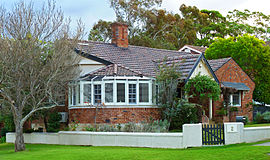East Lindfield, New South Wales
|
East Lindfield Sydney, New South Wales |
|||||||||||||
|---|---|---|---|---|---|---|---|---|---|---|---|---|---|

c. 1930 house, Sydney Road
|
|||||||||||||
| Population | 3,628 (2011 census) | ||||||||||||
| Postcode(s) | 2070 | ||||||||||||
| Location | 13 km (8 mi) NW of Sydney CBD | ||||||||||||
| LGA(s) | Ku-ring-gai Council | ||||||||||||
| State electorate(s) | Davidson | ||||||||||||
| Federal Division(s) | Bradfield | ||||||||||||
|
|||||||||||||
East Lindfield is a suburb on the Upper North Shore of Sydney in the state of New South Wales, Australia. East Lindfield is located 13 kilometres north-west of the Sydney Central Business District in the local government area of Ku-ring-gai Council. Lindfield is a separate suburb, although they both share the postcode of 2070.
Lindfield means "lime tree field". The Lindfield area was settled in the 1850s. The name derives from the native town of early landowner Mr List, who named his house after Lindfield, Sussex, England. When the railway line came through the area in 1890s, the name of the property was used to identify the station and neighbourhood.
Suburban development in East Lindfield occurred mostly in the 1950s and 1960s, so most of the houses in East Lindfield are newer and have a different style to those of Lindfield, which mostly pre-date World War II.
East Lindfield became a separate suburb from Lindfield when it was gazetted on 5 August 1994.
Lindfield railway station is on the North Shore, Northern & Western Line of the Sydney Trains network. Sydney Buses run the 207 route to East Lindfield. East Lindfield is also home to Lindfield East Public School.
At the 2011 census, 21.1% of employed people travelled to work on public transport and 55.0% by car (either as driver or as passenger).
According to the 2011 census, there were 3,628 residents in East Lindfield. Many were families: there was a high rate of married people in East Lindfield, with 64.1% of residents aged 15 years and over being married (the national average was 48.7%), and children under 15 constituted 25% of the population (national average is 19.3%). The most common ancestries in East Lindfield were English 24.8%, Australian 23.5%, Chinese 12.2%, Scottish 7.4% and Irish 7.1%. East Lindfield residents had high incomes, with a median weekly household income of $2,694 compared to the national average of $1,234. There was considerable participation in voluntary work, with 28.3% of people doing official voluntary work in the previous 12 months, which is significantly higher than the national average of 17.8%.
...
Wikipedia
